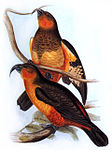List of Strigopoidea
Of the nine species in the New Zealand parrot superfamily Strigopoidea, the Norfolk kākā[1][2] and Chatham kākā[3] became extinct in recent history. The last known individual of the Norfolk Kākā died in its cage in London sometime after 1851,[4] and only between seven[5] and 20[6] skins survive. The Chatham Kākā became extinct in pre-European times, after Polynesians settled the island, between 1550 and 1700, and is only known from subfossil bones.[3] Of the surviving species, the kākāpō is critically endangered,[7][8] with living individuals numbering only 244 (as of 2024).[9] The mainland kākā is listed as endangered,[10][11] and the kea is listed as vulnerable.[12][13] The Nestoridae genus Nelepsittacus consists of four extinct species.
Species list
[edit]Nestoridae
[edit]There are two surviving species and at least one well documented extinct species of the family Nestoridae. Very little is known about the Chatham Kākā, and it may have been con-specific with another Kākā species, or a separate species belonging to the genus.
| Nestorini | |||
|---|---|---|---|
| Common name (binomial name) status |
Image | Description | Range and habitat |
| Kea (Nestor notabilis) |
 |
48 cm (19 in) long. Mostly olive-green with scarlet underwings and rump. Dark-edged feathers. Dark brown beak, iris, legs, and feet. Male has longer bill.[13] | New Zealand: South Island High-level forests and subalpine scrublands 850–1400 m AMSL.[14] |
| South Island kākā (Nestor meridionalis meridionalis) |
 |
Similar to the North Island kaka, but slightly smaller, brighter colours, the crown is almost white, and the bill is longer and more arched in males.[11] | New Zealand: South Island Unbroken tracts of Nothofagus and Podocarpus forests 450–850 m AMSL in summer and 0–550 m in winter.[14] |
| North Island kākā (Nestor meridionalis septentrionalis) |
 |
About 45 cm (18 in) long. Mainly olive-brown with dark feather edges. Crimson underwings, rump, and collar. The cheeks are golden/brown. The crown is greyish.[11] | New Zealand: North Island Unbroken tracts of Nothofagus and Podocarpus forests between 450 and 850 m AMSL in summer and 0–550 m in winter.[14] |
| Norfolk kākā |
 |
About 38 cm long. Mostly olive-brown upperparts, (reddish-)orange cheeks and throat, straw-coloured breast, thighs, rump and lower abdomen dark orange.[15] | Formerly endemic on Norfolk Island and Phillip Island of Australia[2] Rocks and trees[15] |
| Chatham kākā (Nestor chathamensis) |
Appearance unknown, but bones indicate reduced flight capability. | Only known from subfossil bones.[3] | Formerly endemic on Chatham Island of New Zealand Forests[3] |
Strigopidae
[edit]The kakapo is the only member of the family Strigopidae.
| Strigopini | |||
|---|---|---|---|
| Common name (binomial name) status |
Image | Description | Range and habitat |
| Kākāpō (Strigops habroptilus) |
 |
Large rotund parrots 58–64 cm (23–25 in) long; males are larger than females and weigh 2–4 kg (4.5–9 lb) at maturity. Mostly green with brown and yellow mottled barring, the underparts being greenish-yellow. Its face is pale and owl-like.[8] | New Zealand: Maud, Chalky, Codfish and Anchor Islands Climax Nothofagus (beech) and Podocarpus (conifer) forests, regenerating subalpine scrub, snow tussock Danthonia grassland 10–1400 m AMSL.[14] |
References
[edit]- ^ a b BirdLife International (2016). "Nestor productus". IUCN Red List of Threatened Species. 2016: e.T22684834A93049105. doi:10.2305/IUCN.UK.2016-3.RLTS.T22684834A93049105.en. Retrieved 12 November 2021. Database entry includes a range map and justification for why this species is endangered.
- ^ a b "Norfolk Kaka - BirdLife Species Factsheet". BirdLife International. 2008.
- ^ a b c d e Millener, P. R. (1999). "The history of the Chatham Islands' bird fauna of the last 7000 years – a chronicle of change and extinction. Proceedings of the 4th International meeting of the Society of Avian Paleontology and Evolution (Washington, D.C., June 1996)". Smithsonian Contributions to Paleobiology. 89: 85–109.
- ^ Greenway, James Cowan (1967). Extinct and Vanishing Birds of the World (2nd ed.). New York: Dover Publications.
- ^ "Nestor productus - Norfolk Kaka specimen(s) in the ZMA". Nlbif.eti.uva.nl. Archived from the original on 2011-06-08. Retrieved 2008-12-28.
- ^ "Naturalis - Extinct bird: Nestor productus (Norfolk Kaka)". Nlbif.eti.uva.nl. Archived from the original on 2011-06-08. Retrieved 2008-12-28.
- ^ a b BirdLife International (2018). "Strigops habroptila". IUCN Red List of Threatened Species. 2018: e.T22685245A129751169. doi:10.2305/IUCN.UK.2018-2.RLTS.T22685245A129751169.en. Retrieved 12 November 2021. Database entry includes a range map and justification for why this species is endangered,
- ^ a b "Kakapo - BirdLife Species Factsheet". BirdLife International. 2008.
- ^ "Kākāpō Recovery". Department of Conservation. New Zealand. Retrieved 26 September 2024
- ^ a b c BirdLife International (2016). "Nestor meridionalis". IUCN Red List of Threatened Species. 2016: e.T22684840A93049267. doi:10.2305/IUCN.UK.2016-3.RLTS.T22684840A93049267.en. Retrieved 12 November 2021. Database entry includes a range map and justification for why this species is endangered.
- ^ a b c "Kaka - BirdLife Species Factsheet". BirdLife International. 2008.
- ^ a b BirdLife International (2017). "Nestor notabilis". IUCN Red List of Threatened Species. 2017: e.T22684831A119243358. doi:10.2305/IUCN.UK.2017-3.RLTS.T22684831A119243358.en. Retrieved 12 November 2021. Database entry includes a range map and justification for why this species is endangered.
- ^ a b "Kea - BirdLife Species Factsheet". BirdLife International. 2008.
- ^ a b c d Juniper, Tony; Mike Parr (1998). Parrots: A Guide to Parrots of the World. Yale University Press. ISBN 978-0300074536.
- ^ a b Forshaw, Joseph M.; Cooper, William T. (1981) [1973, 1978]. Parrots of the World (corrected second ed.). David & Charles, Newton Abbot, London. ISBN 0-7153-7698-5.
